37 meeting reflections to open and close your meetings
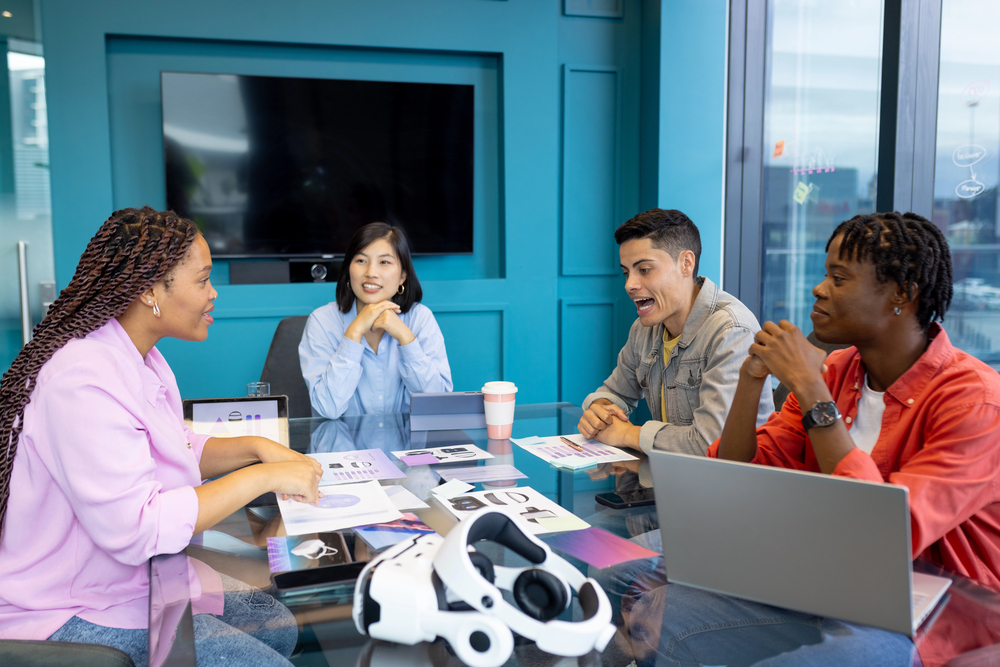
Meetings are often packed with discussions, decisions, and action items—but how often do we take the time to pause and reflect? Incorporating reflection activities into meetings can transform them from routine check-ins into meaningful conversations that drive clarity, connection, and action.
A well-placed reflection exercise can help a group start a meeting with intention, process insights mid-session, and close with a sense of clarity and purpose. Whether you're facilitating a brainstorming session, a team retrospective, or a strategic planning discussion, reflection activities create space for deeper thinking, alignment, and engagement.
This post explores a range of simple yet powerful meeting reflection activities, from quick check-ins to structured debriefs. No matter your team size or format—virtual, hybrid, or in-person—you’ll find reflection techniques that encourage thoughtful participation and help your team get the most out of every meeting.
What are meeting reflections?
Typically, a meeting reflection is a simple question that participants reflect on in silence before then sharing their answer with the group.
Meeting reflections are intentional moments of pause and inquiry that help participants ground in the moment and then share something with the group.
Some team meeting reflections go further, by incorporating physical action or visual elements designed to improve engagement or accomplish a specific purpose such as making a decision or sharing levels of aggreement.
Meeting reflections are most often used at three points during a meeting:
- to open a meeting and help people share how they are feeling, check existing knowledge on the subject of meeting or align on expectations for the session.
- to close a meeting by asking participants about lessons learned, celebrating wins or to reflect on steps they’ll take after the meeting.
- during a meeting to gauge energy levels, check alignment and understanding or make a decision.
These moments of reflection can take different forms depending on the meeting’s purpose and structure. Typically, you’ll ask participants to reflect on something that relates to the topic of the meeting or which allows them to reflect on how they’re feeling and allow them to be more present and engaged in the session.
Whether it’s a quick one-word check-in, a structured debrief, or an open-ended discussion, reflection activities support engagement, enhance group dynamics, and make meetings more purposeful.
In the sections below, you’ll find a combination of simple meeting reflections and more involved reflection activities too. Let’s explore.

Why are meeting reflections important?
Without any moments of reflection, meetings can feel like a blur of conversations and decisions, leaving participants unsure of what really mattered or what comes next.
Reflection activities help counteract this by slowing things down just enough for clarity, alignment, and connection to emerge.
Here’s why they matter:
- They help ground everyone in the meeting. A good meeting reflection is an invitation to put aside what came before or will come after the meeting and be present in the moment. I often use a meeting reflection at the outset as a means to help participants truly land in the session and prepare to contribute.
- They help facilitators tailor their approach and service the needs of the group. A good meeting reflection will give the facilitator insights that will allow them to tailor the agenda to the needs to the group. Participants low on energy? Maybe you move up that energizer. Already have a positive atmosphere in the room, perhaps you can use that to your advantage.
- They set the stage for productive discussions. A good meeting reflection creates a framework for effective discussions. Participants are given a question and then asked to reflect deeply before then sharing in a structured manner. Practicing this skill ensures team members
- They strengthen learning and retention. Pausing to process discussions helps teams internalize key ideas and apply them effectively. Whether used during or at the close of a meeting, a reflection can help ensure lessons learned during the session are retained.
- They create alignment and shared understanding. Reflecting together reduces the risk of miscommunication and ensures everyone is on the same page. It also gives the group an opportunity to address misunderstandings and discuss any sticking points. In this way, a good reflection helps team members with overcoming challenges too!
- They improve decision-making. By allowing space for deeper thinking, reflections help teams make more thoughtful, considered choices. They often provide space to understand the “why” of a decision or opinion, thus informing the process.
- They support team connection and can help build personal relationships. Inviting people to share thoughts, feelings, or feedback fosters a sense of inclusion and psychological safety. Reflecting on a topic together can also help build these kinds of team bonds that carry through to the next meeting.
Incorporating reflection doesn’t have to take up much time, but it can significantly enhance the quality of a meeting. Whether used to open, close, or punctuate discussions, reflection activities help transform meetings from routine obligations into meaningful and productive conversations.
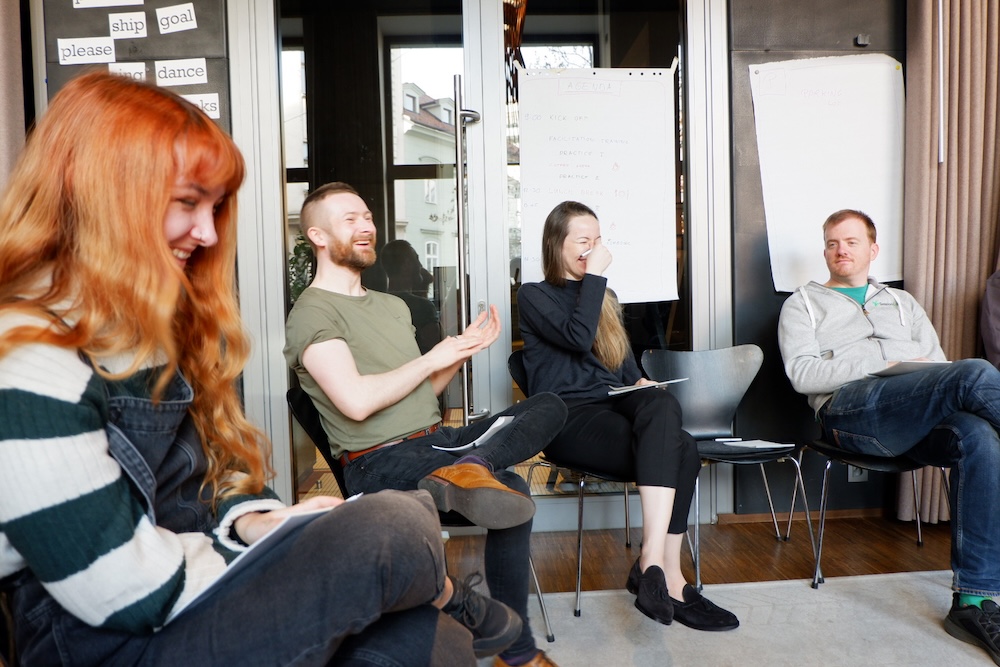
Simple meeting reflections
In this post, you’ll find a collection of reflective meeting activities you can use to open, close or reflect during the meeting. These are facilitator tested, proven activities that you can follow to great effect.
But what if you’re looking for the absolute simplest way to get your meeting participants to reflect? Sometimes, a single good question is all you need.
For best results, it’s worth considering the group you’re working with and the flow of the rest of the meeting. For example, if you’re running a project kickoff, it can be helpful to prime people for goal-oriented work by asking them what they would like to get from this meeting.
On the other hand, if you’re running a general team meeting, asking people to share how they’re feeling may be the best shout for ensuring the meeting is a success.
These are my personal favourite meeting reflection questions that are as simple to use as just asking the group to respond to the question.
Simple reflections to start a meeting:
- Could you describe how you’re feeling today in just one word?
- What do you need in order to participate fully in this meeting?
- What do you want to leave this meeting with?
- What are your hopes for this meeting?
- At the end of this meeting, how will we know it was a success?
- How do we fail this meeting? (Obviously then ensure you think about how to avoid that from happening with the group!)
Simple reflections to close a meeting:
- How do you feel at this point in the meeting?
- What’s something that hasn’t been said yet but is important?
- What’s something we should remember as we move forward?
- Do you need anything to help you contribute to this meeting?
- How are your energy levels?
- Are we ready to move on or is there something more to be said?
Simple reflections to use during a meeting:
- How do you feel as we bring this meeting to a close?
- What was the biggest lesson you learned during this meeting?
- What is your main takeaway from this meeting?
- What are you going to do after this meeting?
- What feedback do you have for this meeting?
- What do you want more of and less of in the next meeting?
Reflection activities for opening a meeting
Kicking off a meeting with reflection activities can set a thoughtful tone and encourage participants to engage more deeply with the topics at hand. These opening exercises provide a valuable opportunity for team members to pause, consider their thoughts and experiences, and share insights that can enrich the meeting’s discussions.
These are some of our favourite workplace meeting reflections that give team members an opportunity to check-in and reflect at the start of a meeting.
| Reflection activity | Length in minutes | Participants | Best For |
|---|---|---|---|
| Check-in / Check-out | 5 – 30 | 2 – 40 | Opening or closing a process, symbolically and in a collaborative way |
| I EXPECT | 3 – 45 | 2+ | Clarifying expectations in any workshop or training situation |
| Who are you? The pirate ship exercise | 10+ | 2+ | Reflecting on attitudes or feelings about a topic, in the organization, team, or project |
| The Feeling Wheel | 5 – 15 | 2 – 20 | Identifying and articulating emotions, developing emotional awareness |
| Paired walk | 15 – 30 | 2+ | Increasing trust, preparing for conflict resolution, and energizing participants |
| Yoga icebreaker and reflection | 10 – 20 | 3 – 30 | Energizing participants, promoting mindfulness |
| Object Meditation | 5 – 15 | 3 – 20 | Opening activities, self-awareness exercises, emotional check-ins |
Check-in / Check-out
The Check-in / Check-out method provides a simple, effective framework for bookending sessions, ensuring participant engagement from start to finish. This technique creates a symbolic and collaborative opening or closing process, inviting every team member to be present, seen, and heard.
To implement Check-in / Check-out, gather the group in a circle, either standing or sitting. For a check-in, each person shares something representing their current state – a feeling, a reflection from yesterday, or a response to a playful prompt like “What animal represents your mood today?”
During check-out, participants might share a key takeaway or their feelings as the session ends. Go around the circle, allowing each person to speak once, uninterrupted.
Check-in / Check-out sets the stage for focused and committed group work. As a closing activity, it offers a crucial moment of reflection and symbolic closure often missed in busy work environments.
I EXPECT
The “I EXPECT” method offers an effective way to uncover and align participant expectations at the start of a workshop or training session. By creating a visual map of collective expectations, this technique helps set the tone for the session and allows facilitators to address any misalignments early on.
To implement “I EXPECT,” divide a flipchart into four quadrants labeled: “The Training,” “The Trainer,” “From Yourself,” and “Other Participants.” Invite participants to share their expectations for each category, either verbally in a group discussion or by writing on sticky notes and posting them in the relevant quadrants.
The “I EXPECT” method encourages participants to reflect on their own role in the learning process, and creates a sense of shared responsibility for the workshop’s success. It also helps the trainer to ensure expectations or additional needs are surfaced and met.
Who are you? The pirate ship exercise
The “Who are you? The pirate ship exercise” uses a vivid metaphor to help participants reflect on their roles, attitudes, and feelings about a topic, project, or within the organization. This activity creates a safe space for people to express themselves metaphorically, often revealing insights that might not surface in regular conversation.
To conduct the pirate ship exercise, show participants an image of a pirate ship with various characters in different positions and situations. Ask each person to choose which character best represents how they feel in relation to the topic at hand. Participants then share their choice and briefly explain why.
For groups who may find sharing personal reflections hard, I find the pirate ship offers an easy way for them to express their perspectives and contribute in a fun yet still useful manner.
The Feeling Wheel
The Feeling Wheel exercise, based on Robert Plutchik’s Feeling Wheel, helps participants identify and articulate their emotions at the start of the meeting and create shared understanding in a group.
Start The Feeling Wheel by setting a safe, reflective tone, emphasizing that all emotions are valid and important. Participants examine the Feeling Wheel, using a sticker or post-it to mark the emotion that best describes their current state. If comfortable, each person shares their chosen emotion, exploring why they feel that way and considering related feelings on the wheel.
The Feeling Wheel exercise offers versatility in application. It can explore hypothetical scenarios (“How might we feel when…?”) or serve as part of a daily emotional check-in. Starting meetings with this exercise can help surface and reduce underlying tension and build empathy within teams. Knowing where people are at helps us understand their behaviour and by checking in with our feelings, we can be more self aware and in control too.
Paired walk
The Paired walk activity transforms team dynamics by inviting participants to step outside, pair up, and engage in meaningful conversation while walking together. This technique creates a relaxed atmosphere, free from the distractions of devices or meeting rooms, often leading to more open and honest conversations.
To conduct a Paired walk, participants pair up, ideally with someone they don’t know well. The facilitator allocates a specific amount of time (usually 15-20 minutes) for the walk and talk, suggesting a topic for discussion such as personal experiences, team challenges, or ideas related to the session’s theme.
Paired walks offer versatility in application, serving as an energizer, a trust-building exercise, or a precursor to addressing challenging topics. Often, the change in scenery and action of walking can help shake things loose and help folks reflect in ways that might not be able to in a regular meeting room.
Yoga icebreaker and reflection
Incorporating movement and mindfulness into meetings can rejuvenate participants and enhance focus. The Yoga Icebreaker and Reflection activity combines gentle yoga stretches with reflective prompts, creating a refreshing start to any session.
Begin by guiding the group through simple breathing exercises to center attention. Progress to easy stretches, such as neck rolls and shoulder shrugs, which can be performed seated or standing.
As the group moves through each pose, introduce a reflective question related to the meeting’s theme or simply ask the group to set an intention for the rest of the day, encouraging participants to ponder silently. This blend of physical movement and introspection not only relaxes the body but also primes the mind for engaged and thoughtful participation.
Object Meditation
Object Meditation is a mindfulness exercise designed to help participants become present and aware and move past any distractions at the start of a meeting or workshop.
Start the Object Meditation by asking participants to select a small object from their immediate surroundings—such as a pen, mug, or book—and hold it in their hands. Guided by the facilitator, they close their eyes (or soften their gaze) and take a moment to check in with their thoughts and emotional feelings, observing these without judgment.
Attention is then directed to the chosen object, noting its texture, weight, and other sensory details. Participants are encouraged to visualize transferring any unhelpful thoughts or feelings into the object, allowing them to release what doesn’t serve them in the present moment.
I particularly enjoy Object Meditation in a virtual environment: inviting team members to show the object to the camera can help bring the group closer, despite the presence of the screen.
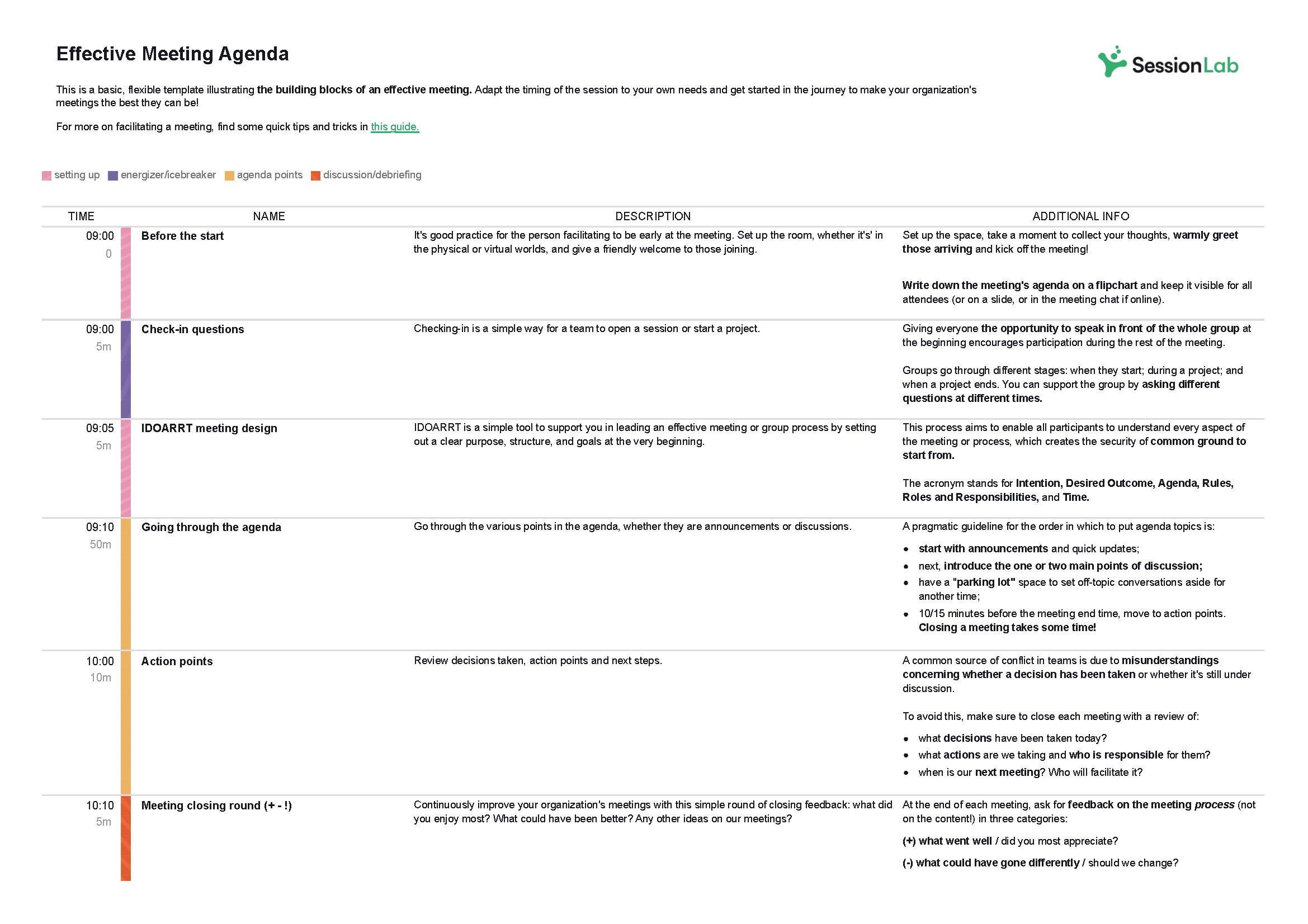
Reflection activities for closing a meeting
As your meeting draws to a close, it’s essential to wrap things up in a way that reinforces key takeaways and sets the stage for future action. This is where reflection activities come in – they provide a structured, engaging way to consolidate learning, gather feedback, and ensure everyone leaves on the same page.
In my experience, closing meetings in this way has a compounding effect too. Participants get used to thinking about what they’ve learned and what next steps will be at the close of a session and they bring this practice to future meetings too.
| Reflection activity | Length in minutes | Participants | Best For |
|---|---|---|---|
| One Breath Feedback | 5 – 15 | 2 – 20 | Focused feedback rounds, saving time while ensuring all voices are heard |
| Thankfulness Tree | 5 – 15 | 2+ | Reflecting on gratitude, revisiting key learnings, creating a visual record |
| I Used to Think… But Now I Think… | 5 – 15 | 4+ | Identifying learning points, revealing perspective shifts, measuring behavioral changes |
| Letter to Myself | 5 – 30 | 2 – 40 | Applying insights, setting future goals, personal reflection |
| Start, Stop, Continue | 10 – 60 | 1 – 10 | Evaluating processes, developing next steps, providing structured feedback |
| Next steps (after this meeting I will..) | 5 – 10 | 4 + | Reflecting on immediate next steps, ending on a positive note |
One Breath Feedback
One Breath Feedback solves the problem of closing reflections running over by keeping contributions short, sharp, and to the point. Participants take turns sharing their feedback in a single breath—usually around 20-25 seconds.
The process is simple: sit in a circle (or small groups), explain the rules— participants share their feedback or closing reflections in the space of a single breath—then go around the group and share. The time limit forces participants to be concise and intentional, while the quick-fire nature keeps energy high and engagement strong. It’s a great way to wrap up a session on a high note, ensuring everyone’s voice is heard without dragging things out or losing momentum.
Thankfulness Tree
The Thankfulness Tree is a powerful way to close a session with positivity and meaningful reflection. Start by create an image or shape of a tree on a wall or whiteboard. Instruct participants to trace around their hand on a sheet of paper and cut it out, then write down something they’re grateful for or a key insight from the session on a paper leaf and attach it to the tree.
As the tree fills up, it becomes a visual representation of shared learning and appreciation. This method not only encourages personal reflection but also creates a visual representation of the session’s impact. (Remember to take photos!) Thankfulness Tree works well for both in-person and virtual settings, where participants can submit their responses digitally to form a collaborative Miro board.
I Used to Think… But Now I Think…
I Used to Think… But Now I Think… is a highly effective reflection framework that helps participants reflect on how their understanding has evolved during a session.
Participants simply complete the sentence:
- “I used to think…” (a belief or assumption they held before the session)
- “But now I think…” (how their perspective has changed)
Give team members are few minutes to reflect silently before sharing with the group, either collecting the responses on a flip chart or sharing in a circle.
I Used to Think… But Now I Think… highlights the power of learning and transformation by making growth tangible. Sharing reflections in small groups or as a whole can spark insightful discussions and reinforce key takeaways. For facilitators, it also provides valuable feedback on the session’s impact.
Letter to Myself
Letter to Myself helps participants turn insights into action by writing an inspiring letter of key takeaways to their future selves.
At the end of a session, participants reflect on what they’ve learned and how they want to apply it in the future. They then write a letter detailing their goals, commitments, or words of encouragement to their future selves. Facilitators can mail the letters later or participants can set a digital reminder to revisit them.
Letter to Myself creates a tangible link between learning and future action, ensuring that insights aren’t just inspiring in the moment, but actually lead to real-world change. If your group gets into a habit, these letters can also form the backbone of continuous improvement too!
Start, Stop, Continue
“Start, Stop, Continue” is a straightforward and effective method for teams to reflect on current practices and identify actionable steps for improvement.
In this activity, participants individually consider a specific situation, process, or behavior and brainstorm on post-it notes under three headings:
- Start: New initiatives or behaviors that could enhance performance or outcomes.
- Stop: Current practices that are hindering progress or are no longer beneficial.
- Continue: Existing actions that are effective and should be maintained.
After individual reflection, participants share their insights with the group by sticking their post-its on a shared whiteboard. After some clustering and discussion, the group may then choose to vote on actions to take. Start, Stop, Continue is incredibly flexible: I’ve used it with groups and for solo reflection too. It can be used as both an opening activity to set intentions or a closing exercise to identify areas of learning and plan future actions.
Next steps (after this meeting I will..)
Next steps is a simple but effective meeting reflection activity that encourages participants to share the actions they’ll take following the meeting. Here’s the rub: one of those actions is work focused, while the other is something nice they’ll do for themselves.
Start this activity by getting the group into a circle. Next, raise your right hand and say “After this meeting I will…” completing the sentence with an action step you’ll take after the meeting. Then, raise your left and say “but before that I will…” and complete the sentence with something you’ll do for yourself, such as taking a break or making a nice drink. Finish by giving a high-five to the person next to you, who will continue the activity.
Next steps is a fast, easy-to-run reflection exercise that invites participants to reflect on what they need to do as individuals, as well as which action items to tackle next.
Meeting reflection activities for during a meeting
In this section, we’ll explore some deeper reflective activities that are primarily used at the mid-point of a meeting to help a group reflect and explore a subject more deeply.
A notable exception being the Quick Reviews activity, which is a great method for getting a temperature check at any point during a meeting.
These activities are great to use when you want to explore a problem space and find moments for thoughtful reflection on bigger topics as a group. These can provide some inspiration for how you might approach deeper reflection and provide an effective framework for that reflection.
| Reflection activity | Duration (min) | Participants | Best for |
|---|---|---|---|
| W³ – What, So What, Now What? | 30 – 60 | Not specified | Looking back on progress and deciding what adjustments are needed |
| Team Self-Assessment | 60 – 120 | 2 – 10 | Exploring how teams work together and identifying areas for improvement |
| Gap Analysis | 10 – 20 | 6 – 50 | Determining the differences between the present situation and a desired future state |
| Quick Reviews in 2 minutes | 2+ | 5 – 20 | Quickly reviewing content or atmosphere at the end or between group activities |
| The 5 Whys | 30 – 60 | 2 – 10 | Getting to the core of a problem or challenge through repeated questioning |
| The Blind Side | 30 – 45 | 5 – 15 | Uncovering hidden information, enhancing team awareness, improving decision-making |
W³ – What, So What, Now What?
The W³ – What, So What, Now What? method is a powerful tool for aligning perspectives and moving teams forward. This structured reflection process helps groups make sense of complex experiences together, reducing misunderstandings that can derail progress.
Participants begin by focusing on What happened, collecting objective observations. Next, they explore So What those observations mean, identifying patterns and drawing conclusions. Finally, they determine Now What actions logically follow. This progression ensures all voices are heard while distilling insights and shaping new directions.
What, So What, Now What? is a great method to use when managing conflict or trying to unstick groups that have become blocked on a tough problem. If you’re facilitating a group/topic that has the potential to become heated or messy, this is a wonderful framework for moving from reflection to productive action.
Team Self-Assessment
Team Self-Assessment is a structured process for groups to evaluate their shared habits, dynamics and ways of working. This method encourages open, honest reflection on six key dimensions of team performance, uncovering both strengths and growth areas.
The process begins with individual reflection on each dimension, with team members completing statements like “As a team, we…” The group then shares and clusters insights, creating a collective map of team perceptions. Through dot voting and discussion, priority areas for celebration or improvement are identified.
Team Self-Assessment makes implicit team dynamics explicit, creating a safe space for constructive dialogue. Newly formed groups can use this method to start strong, while established teams can leverage it to elevate their performance. The final output of the assessment is a collaborative document of decisions made and team best practices which the group will refer to in the future.
Gap Analysis
Gap Analysis is a simple reflection exercise that helps groups visualize the distance between their current reality and future goals. This method makes it easier to identify and tackle obstacles, bridging the divide between present circumstances and desired outcomes.
To conduct a Gap Analysis, the group first describes their desired future state on one flipchart. They then capture their present situation on another. With these two points clearly defined, participants brainstorm the gaps between them. This visual approach clarifies necessary changes and sparks creative problem-solving.
Gap Analysis transforms vague aspirations into actionable plans by breaking down the journey from present to future into manageable steps. The method is particularly effective for project planning, strategic visioning, or any situation requiring a shift from “what is” to “what could be.”
Quick Reviews in 2 minutes
Quick Reviews in 2 minutes is a collection of short, engaging meeting reflections that help capture group sentiment without disrupting session flow. These micro-reflection techniques help participants process learning and reconnect with the group in a time-efficient manner.
The method includes five lightning-fast techniques such as telling a brief story about the last activity, visualizing magic moments with a short meditation, or giving rapid-fire positive feedback. Each approach takes just 2 minutes, allowing facilitators to quickly gauge participants’ experiences or boost energy levels.
Quick Reviews in 2 minutes is particularly useful when wrapping up workshop segments, transitioning between activities, or when you want to clarify where the group is at before potentially changing things up. Quick Reviews shine in situations where time is limited but reflection and sharing remain crucial.
The 5 Whys
The 5 Whys technique is a deceptively simple method for uncovering the root cause of problems. Originally developed by Toyota, this approach helps teams peel back layers of an issue to reveal its core.
To implement The 5 Whys, start by clearly stating the problem. Then, ask “Why?” five times in succession, using each answer as the basis for the next question. This process of continual questioning pushes participants beyond surface-level explanations, often revealing surprising root causes.
The 5 Whys can be applied to a wide range of issues, from technical problems to interpersonal conflicts and personal development. By encouraging deeper reflection and moving beyond our kneejerk thoughts, The 5 Whys is an easy to get groups to deepen their understanding.
In some cases, it can be helpful to provide some direction or examples for continued reflection. If participants get stuck, invite them to think of the reason behind their first answer or give an example. In my experience, if people get stuck or think they’re done on first try, it can also be helpful to ask them to think of “Why is this important?” on both an organizational and personal level.
The Blind Side
The Blind Side is a reflective activity designed to help teams identify and address unknown factors that may impact their success.
In this exercise, a facilitator prepares a visual with four quadrants labeled: “Know/Know,” “Know/Don’t Know,” “Don’t Know/Know,” and “Don’t Know/Don’t Know.” Participants collaboratively populate each section with relevant information, starting with what they are aware they know and progressing to areas where they are unaware of their lack of knowledge.
This structured approach encourages open dialogue, highlights hidden assumptions, and can help create a culture of continuous learning and inter-team sharing.
By the end of the session, the team gains a comprehensive understanding of their knowledge landscape, identifying both strengths and gaps. This awareness is crucial for anticipating challenges, leveraging untapped resources, and enhancing overall team performance.
Final thoughts on meeting reflections
Meetings shouldn’t feel like a whirlwind of unstructured discussions that leave participants frazzled or uncertain about the next steps.
By integrating reflection activities, you create opportunities for deeper engagement, shared learning, and meaningful takeaways. Whether it’s a quick check-in to set the tone, a mid-meeting pause for alignment, or a closing exercise to capture insights, these meeting reflections help ensure that gatherings are not just productive, but also valuable experiences for everyone involved.
The best part? Reflection doesn’t have to take up much time—it just needs to be intentional. By choosing the right activity for your team and context, you can help the group be present, hold more productive discussions and encourage more meaningful engagement too.
So the next time you plan a meeting, ask yourself: How can a moment of reflection help us get more out of this conversation? Chances are, the answer will lead to more thoughtful discussions and improved collaboration.
More resources:
- See this collection of tried-and-tested meeting agenda templates to help improve the structure and outcomes of your future meetings.
- Reflective activities are a great foundation for workshops and training sessions too. See our guide on how to plan a workshop or our step-by-step process for creating a training session for tips on how to incorporate them into a learning flow.
- Looking for a simple meeting icebreaker for your next online meeting? See our collection of icebreakers for virtual meetings to instantly engage your remote team.
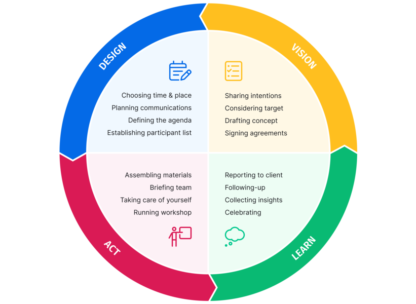

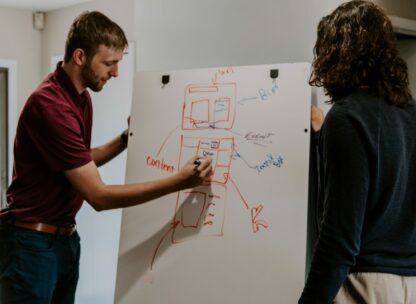
Leave a Comment